Agronomy Update: Importance Of Early Scouting, Stages Of Corn And Soybean Emergence
BY DAIRYLAND SEED AGRONOMY TEAM
Back to Basics 101
It is vitally important to scout fields already planted. We understand there are hundreds of things going on at the same time in the spring and early summer. Please scout -- early detection of issues is essential to allow enough time to possibly take corrective action. Don’t wait to look at fields for the first time until you are back in the field with a post herbicide application or at side dress time. Often, late observance of issues is too late to make wise economic corrective action. Keep in mind that soils that are 50-55 or less degrees may delay emergence up to three weeks. As soils warm to 55+ degrees, emergence may occur within one week. Pay extra attention to fields that are slow to emerge and determine if it is only slow to emerge due to cold temperatures or if other issues are affecting emergence.
Dig up seedlings and check the plants for following symptoms:
- Seed rots and seedling blights (rotting seed and brown discoloration of mesocotyl and seminal roots or missing plants)
- Uneven emergence, plant wilting and discoloration, brown roots that appear burnt, missing plants, leafing out underground etc.)
- Herbicide injury
- Insect issues (seed corn maggot, wireworms, cutworms, armyworms)
- Planter issues (seed depth or skips and doubles)
If plants are missing entirely, check to see if you can even find any seed(s) where plants should be. At times, decisions to take corrective action are not easy to make. The agronomy team is ready to help you with any questions or concerns.
Soybean Germination
A little Soybean Physiology 101 as you await soybean emergence:
- Soybeans must take on (imbibe) about 50% of their weight equivalent in water to germinate.
- Germination is both moisture and temperature driven.
- Germination is driven by hormonal systems (not well understood yet) within the seed.
- Once germination is initiated, the cotyledons – the two “halves” of the soybean seed – begin to swell. The radicle, or primary root, emerges from the seed.
- As cell division occurs, the root elongates and the hypocotyl (stem) elongates between the cotyledons and begins to push upwards.
- As the hypocotyl elongates, the cotyledons are oriented downward and are “pulled” upward by the elongating hypocotyl.
- Some 100-125 Growing Degree Days after planting, the neck, or curved part of the hypocotyl above the cotyledons, emerges above the soil surface, and, as it continues to grow upward, the cotyledons are pulled upward through the soil surface.
- Once the cotyledons are above the soil surface, they stretch out and turn upward and open up. Upon opening, the first true leaves – the unifoliate leaves – are exposed and open up and enlarge. The stem forms (epicotyl) and subsequently additional leaves form and emerge. After the two unifoliate leaves (one leaflet each) are open, all subsequent leaves are trifoliate leaves – each leaf is comprised of three leaflets.
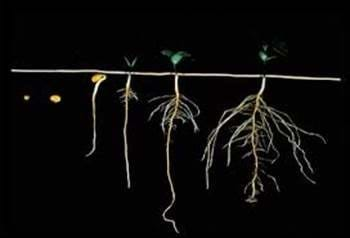
Courtesy “How a Soybean Plant Develops,” Iowa State University
Potential Issues at Germination and Emergence
- Too dry – not enough moisture available to initiate germination
- Too cold and wet – germination and emergence processes are slowed significantly, to the point at which seed may rot or otherwise be compromised. Fungicide seed treatment is very useful and provides good protection for the first two to three weeks.
- Crusting soil – difficulty in emergence – the neck may emerge but the cotyledons are unable to push through the crust
- Soil insects feed on seed and seedlings. The longer emergence takes, the more likelihood of injury from insects. Seed treatment insecticide is very important and useful.
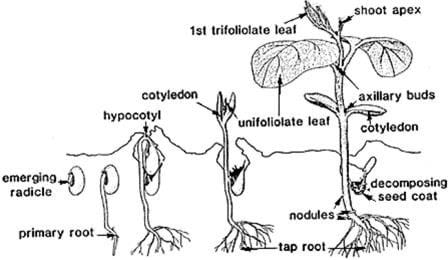
Courtesy University of Minnesota Extension
Stages of Corn Emergence
In the last week to 10 days many areas (but not all) have had favorable weather that has allowed farmers to plant corn. A corn seed has a few processes that it needs to accomplish prior to soil emergence. One of the processes is germination, which takes place when a seed takes in or imbibes roughly 30% of its weight in water, during this process the seed will swell slightly. In most instances germination or seed swelling takes roughly 10-20 Growing Degree Units (GDU’s). (This is shown below and on the left.)
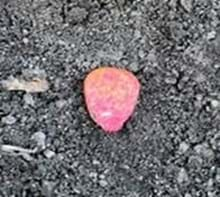 |
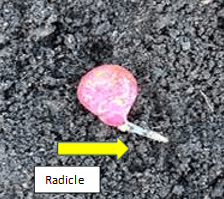 |
Once germination has initiated, the radicle root will start to emerge, it normally takes 30-40 GDU’s for the radicle root to emerge. (This is shown in the photo above and on the right). The radical always emerges from the tip of the embryo and will orient itself due to gravity so it is growing down, regardless of where the embryo of the seed is pointed, the ability of the plant to sense gravity is called Gravitropism or Geotropism.
The next process to take place is for the coleoptile to emerge from the seed (as shown below and on the left). It normally takes 50-60 GDU’s for the coleoptile to emerge from the seed. Starting between 60-70 GDU’s, the seminal root system will start to emerge from the seed and almost immediately start taking in water and nutrients for the plant to continue to grow. The seminal root system and the radicle will anchor the plant and act as the main root system for the plant until VE (shoot/spike coleoptile emergence) and will continue to grow until V3 (three collared corn).
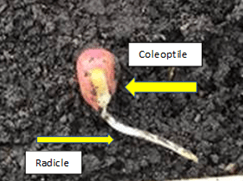 |
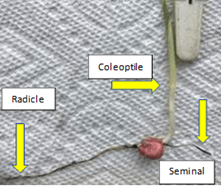 |
It normally takes 100-150 GDU’s for the coleoptile to emerge (VE) from the soil surface, (as shown above and on the right) with weather conditions and genetic makeup being factors affecting this process. At VE, the coleoptile will cease to elongate and the foliage that follows will be the embryonic leaves.
|
Plant / Leaf Stage |
Growth Stage |
GDU's |
|
Germination |
10 to 20 |
|
|
Radicle Root Emergence |
30 to 40 |
|
|
Coleoptile Emergence Seed |
50 to 60 |
|
|
Seminal Root Emergence |
60 to 70 |
|
|
Coleoptile Emergence Soil |
VE |
100 to 150 |
Corteva Technology Use Agreements
All growers with orders for any Corteva Agriscience brand seed product, regardless of crop or trait (including non-GM products) need to have a signed Corteva Technology Use Agreement in place by September 1. Growers should sign the Corteva Technology Use Agreement electronically at www.agcelerate.com. Signing electronically is preferable, however, paper copies are available at www.traitstewardship.com.
 |
 |
 |
 |
 |
| Brian Weller Western Region 507.456.3034 |
Dan Ritter Central Region 219.863.0583 |
Branden Furseth Northern Region 608.513.4265 |
Rod King Eastern Region 574.596.6721 |
Terry Jones Eastern Region 419.630.3115 |
